
Banneville-la-Campagne is a commune in the Calvados department in the Normandy region of north-western France.

Chogha Zanbil is an ancient Elamite complex in the Khuzestan province of Iran. It is one of the few existing ziggurats outside Mesopotamia. It lies approximately 30 km (19 mi) southeast of Susa and 80 km (50 mi) north of Ahvaz. The construction date of the city is unclear due to uncertainty in the chronology of the reign of Untash-Napirisha but is clearly sometime in the 14th or 13th century BC. The conventionally assumed date is 1250 BC. The city is currently believed to have been destroyed by the Neo-Assyrian ruler Assurbanipal in about 645 BC, along with the Elamite capital of Susa though some researchers place the end of occupation in the late 12th century BC. The ziggurat is considered to be the best preserved example of the stepped pyramidal monument by UNESCO. In 1979, Chogha Zanbil became the first Iranian site to be inscribed on the UNESCO World Heritage List.
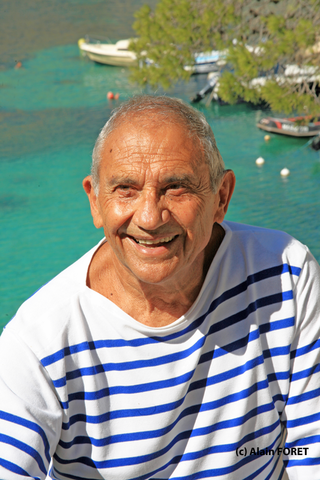
Albert Falco was a French scuba diving veteran and champion of underwater conservation. He was one of the longest-serving diving companions of Jacques Cousteau, Chief Diver, and later Captain of the RV Calypso. He lived in France and was active in preserving aquatic ecosystems. He played several leading roles on Cousteau's films, like The Silent World (1956), World Without Sun (1964) and Voyage to the Edge of the World (1976). Falco was the author of a non-fiction book, Capitaine de La Calypso.

Fissurella fischeri is a species of sea snail, a marine gastropod mollusk in the family Fissurellidae, the keyhole limpets.

Fissurella gaillardi is a species of sea snail, a marine gastropod mollusk in the family Fissurellidae, the keyhole limpets. It occurs in Cape Verde.
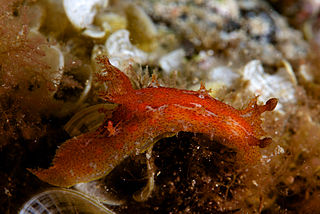
Plocamopherus is a genus of sea slugs, specifically nudibranchs, shell-less marine gastropod molluscs in the family Polyceridae, subfamily Triophinae. A unique character of Plocamopherus species is a globular bioluminescent organ at the tip of the pair of appendages which are placed just behind the gills. Many species are known to be nocturnal and several are from deep water. They feed on bryozoans.
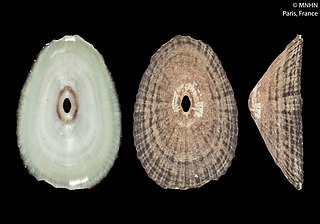
Fissurella emmanuelae is a species of sea snail, a marine gastropod mollusk in the family Fissurellidae, the keyhole limpets and slit limpets.
Ethadophis foresti is an eel in the family Ophichthidae. It was described by Jean Cadenat and Charles Roux in 1964. It is a marine, deep water-dwelling eel which is endemic to Cape Verde, in the eastern Atlantic Ocean. It dwells at a depth range of 25–30 metres, and inhabits the continental shelf, where it forms burrows in mud or sand. Males can reach a maximum total length of 32.1 centimetres.
Plocamopherus lucayensis is a species of sea slug, a nudibranch, a shell-less marine gastropod mollusk in the family Polyceridae.
Plocamopherus maculapodium is a species of sea slug, a nudibranch, a shell-less marine gastropod mollusk in the family Polyceridae.
Plocamopherus pecoso is a species of sea slug, a nudibranch, a shell-less marine gastropod mollusk in the family Polyceridae.
Plocamopherus pilatectus is a species of sea slug, a nudibranch, a shell-less marine gastropod mollusk in the family Polyceridae.
Plocamopherus margaretae is a species of sea slug, a nudibranch, a shell-less marine gastropod mollusk in the family Polyceridae.
Kaloplocamus dokte is a species of sea slug, a nudibranch, a shell-less marine gastropod mollusc in the family Polyceridae.
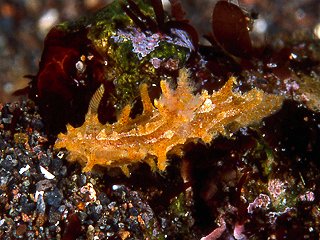
Kaloplocamus peludo is a species of sea slug, a nudibranch, a shell-less marine gastropod mollusc in the family Polyceridae.
Kaloplocamus maru is a species of sea slug, a nudibranch, a shell-less marine gastropod mollusc in the family Polyceridae.
Kaloplocamus maculatus is a species of sea slug, a nudibranch, a shell-less marine gastropod mollusc in the family Polyceridae.

The Calypso class consisted of two spéronares constructed at Corfu, one in 1812 and one in 1813. The two vessels, Calypso and Nausicaa, appear to have been highly similar, and Nausicaa was described as fast both under sail and oars.
Plocamopherus fulgurans is a species of sea slug, a nudibranch, a shell-less marine gastropod mollusk in the family Polyceridae.
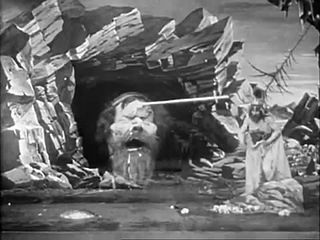
The Mysterious Island, sometimes advertised with the subtitle Ulysse et le géant Polyphème, is a 1905 French short silent film by Georges Méliès. It was sold by Méliès's Star Film Company and is numbered 750–752 in its catalogues. The film is four minutes long.









